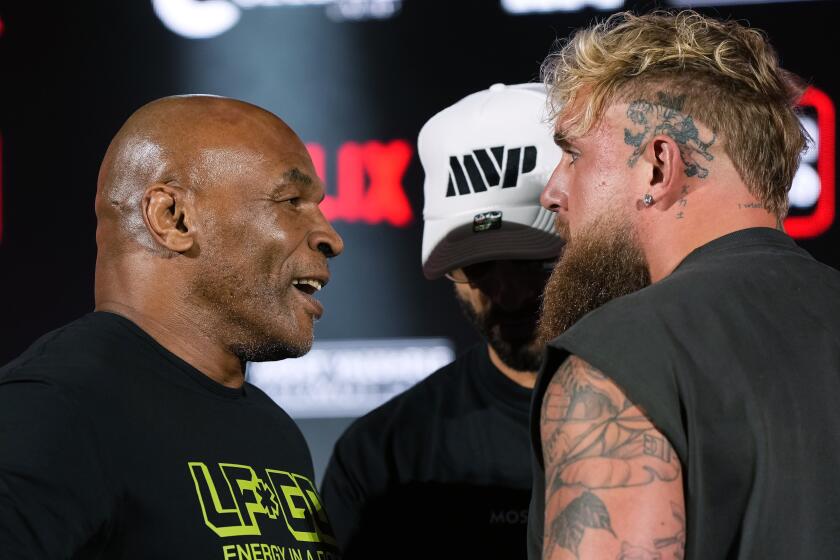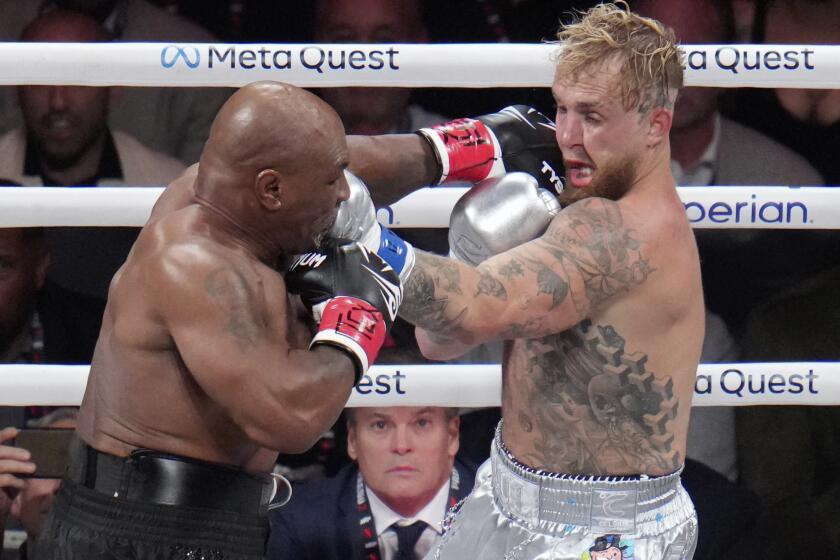STREET FIGHT
It’s all about territory. War and games, from the Balkans to baseball, who controls the seaport, who controls the strike zone--it’s all about territory.
In boxing, war and games come together. The territory amounts to not even 400 square feet, the size of a boxing ring, but every square inch of it matters. The metaphor that relates boxing to life is simple--to gain advantage, I must be aggressive, and when I’m aggressive I’m exposed to failure. When a fighter throws a punch, then he is wide open to being hurt. He is also wide open to being knocked out, having his career ended, or even being killed.
For the Oscar De La Hoya-Shane Mosley fight Saturday, a larger territory is at risk. The territory is Los Angeles, which for the moment is more important than the rest of the world.
Three of the top 10 fighters in the world, pound for pound, are from Southern California--De La Hoya, Mosley and Fernando Vargas, who is waiting in the wings in Oxnard. This may be the first time one area produced three fighters of roughly the same weight and of such high quality at the same time.
If you’re a fighter, this is a problem. Saloons and gyms are full of arguments about who’s the greatest “pound for pound” fighter at any moment--every boxing publication has its own list--but there’s an understanding that it cannot really be known. It’s a “mythic” title, they say. You can’t compare Muhammad Ali to Harry Greb because 60 years and 60 pounds separate them.
“Pound for pound”--a term frequently misused--actually appeared first in the late 1940s, associated with Sugar Ray Robinson. It was not exactly comparing apples to oranges, more like big apples to little apples. It allowed for the assertion that Robinson, at 150 pounds, was a better fighter than, say, Joe Louis at 190 pounds. It became part of the Robinson mantra, “Best fighter in the world, pound for pound.”
When Robinson retired, the term disappeared for nearly 20 years, revived in the late ‘70s by Bert Sugar for Ring magazine. Sugar began running a “top 10 pound for pound ranking” as the era of great welterweights and middleweights evolved--the years of Sugar Ray Leonard, Marvin Hagler, Thomas Hearns, Roberto Duran--and the phrase was back.
Every boxing publication and television outlet promotes its monthly views of who this mythic pound for pound champ really is.
Usually, boxing fans will never know.
De La Hoya and Mosley are the same size, however. And, to their credit, each wants to fight the other, even at great risk. Is it to lay claim to the “mythic” title of best in the world pound for pound? Of course not.
They want to clarify who’s the best fighter in L.A.--their hometown. The rest is for hangers-on to argue about. This is to settle things on the streets of East L.A. and Pomona. And maybe, later, Oxnard.
Ask Johnny Tapia and Danny Romero Jr. what they were fighting for a couple of years ago in their bantamweight title fight--the world title belt was fine but they were really after the flag of Albuquerque, where they grew up. The fight had to be moved from Albuquerque to Las Vegas because police feared a riot, regardless of the result. Tapia won. They’re pals now. They want a rematch.
De La Hoya has been criticized for having moved from his home neighborhood but he put half a million dollars into rebuilding the historic Resurrection Gym in East L.A. and his entire corner is from the neighborhood, for which boxing purists have criticized him incessantly. Ali moved from Louisville, Louis moved from Detroit, Robinson moved, and George Foreman moved from the fifth ward in Houston to the suburbs--and nobody cared. Some of the resentment comes from the ageless American pastime of criticizing success. De La Hoya’s nickname, “the Golden Boy,” probably didn’t help, since it wasn’t in the homeboys’ lexicon, but from the beginning, Oscar was fighting main events. He has never been on an undercard, even in his first fight.
Sugar Ray Leonard was held at a bit of a distance among African American fight fans--too pretty, too successful, too much part of the establishment?--until he beat Duran and Hearns and then, at last, the neighborhood came around.
No man is a hero in his hometown, it is said.
It took a loss to Felix Trinidad, on miscalculated late-round tactics, for De La Hoya to gain respect of the Eastern writers. Check the papers, it was late in Ali’s career before most sportswriters began acknowledging his greatness.
Mosley came up on the undercards--I saw him at the Olympic Auditorium in the early days, fighting preliminaries for main-event fighters who have since disappeared. Now he’s the main event. He was one of those guys about whom you say, “Who’s that guy?” He was that good at the beginning but he was fighting in the shadows of everybody else, noticeably De La Hoya.
He still lives in Pomona. His father functions as dad, manager, brother, friend.
Mosley talks about the “territory” of the ring, the need to make it his own. The bigger territory, he acknowledges, is Los Angeles. That’s what the fight is about.
A little about boxing’s history in L.A.: It’s not a city of heavyweights--only Jim Jeffries, world champion from 1899 to 1904--and Jerry Quarry (top 10 fighter in the glory decades of heavyweights, the ‘60s and ‘70s)--are noteworthy. So was Ken Norton, who fought out of L.A. though he hailed from San Diego. But in the lighter weights, L.A. has shined.
Henry Armstrong, who moved to L.A. from Mississippi as a teenager, may be the only man who can seriously challenge the immortal Sugar Ray Robinson’s claim as the greatest fighter, pound for pound, of all time. Armstrong held three weight titles concurrently--featherweight through welterweight--and fought to a contested draw at Hollywood’s Gilmore Field for the middleweight crown against Ceferino Garcia in a fight in which he had two points deducted for butting. This is somewhat akin to Prince Hamed beating Floyd Mayweather, Kostya Tszyu, De La Hoya, Mosley, Fernando, and Trinidad, then fighting to a draw with Roy Jones Jr. “Hammering Henry” Armstrong was among the greatest ever.
Old-timers remember fights at Wrigley Field (41st and Avalon) where the triple-A baseball franchise played) including a Sugar Ray Robinson-Bobo Olson title fight. There were fights at Gilmore Field, home of the Hollywood Stars, and Hollywood Legion Stadium, as well as the venerable Olympic Auditorium which was ruled by Aileen Eaton. In addition to the Fabulous Forum there were fights at the Country Club in Reseda and fights at the Friars Club and, recently, there was a televised fight card on Hugh Hefner’s tennis court at the Playboy mansion.
Art Aragon, the original Golden Boy, drew movie stars and mobsters and beautiful women, but he was never a champion. We’ve had Mando Ramos, Richie Sandoval and “Superfly” and three wars between “Indian Red” Lopez and Hedgemon Lewis. Chiquinino Hernandez and Zack Padilla and the Ruelas brothers in recent times. Robert Garcia is still a serious fighter as well.
But, until now, the greatest single night in L.A. boxing history was May 24, 1974 when the Sports Arena sold out for a non-title fight against two of L.A.’s greatest, schoolboy Bobby Chacon and the incomparably tough Danny “Little Red” Lopez.
Though Chacon won on a ninth-round technical knockout, each man hurt the other throughout. Each later became a featherweight champion. The fight elevated each man and added to Lopez’s mystique as a fighter who, when floored, seemed inevitably to rise from the canvas to return the favor.
When Lopez, who works construction locally, makes a rare public appearance at a fight, the young fighters flock to meet him. In the age of HBO and Showtime pay-per-view fights, Little Red Lopez would be a star attraction. He was the Arturo Gatti of his day. The equally popular Chacon, who shows effects from his many wars, may be the only boxer to have fought in Ring magazine’s “fight of the year” in consecutive years.
The battle for the heart of Los Angeles takes many forms. The turf wars of our urban gangs are about, among other desperate things, nothing more than territory. Gangs are named after streets, after all. In the less violent but frequently as obsessive fervor of a USC-UCLA football game, all that matters is bragging rights at the country club. Who can remember the Trojans’ or Bruins’ record in any given year? But every alumnus knows who won the city title.
This battle for Los Angeles is between two men who have known each other most of their lives. They’re not friends so much as respected adversaries. They sparred as amateurs--each camp has a different version of what happened.
I asked De La Hoya if it meant anything to settle for once and all who was the best fighter in L.A.
“The only thing that matters is getting a devastating win on the 17th,” he said.
I asked Mosley the same question.
“It’s greater than the title,” he said. “Two homeboys in the city--we’ll settle it.”
And another homeboy, Vargas, sitting at home in the Oxnard neighborhood of his youth, waits to have his say in the matter.
Saturday’s fight is the biggest in the history of this city, but there’s something bigger at stake--bragging rights in the neighborhood.
(BEGIN TEXT OF INFOBOX / INFOGRAPHIC)
OSCAR DE LA HOYA
Hometown: Montebello
Height: 5-10 1/2
Reach: 73 1/2
Record: 32-1
Knockouts: 26
SHANE MOSELY
Hometown: Pomona
Height: 5-9
Reach: 74
Record: 34-0
Knockouts: 32
More to Read
Go beyond the scoreboard
Get the latest on L.A.'s teams in the daily Sports Report newsletter.
You may occasionally receive promotional content from the Los Angeles Times.









